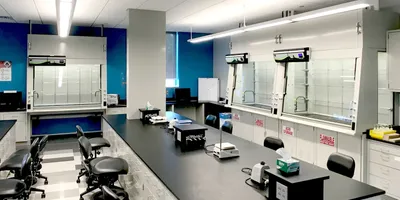Big Picture
Rethinking Lab Air to Advance Sustainability
This article series explores how labs can improve sustainability and safety by rethinking air handling and filtration strategies. From reducing energy-intensive ventilation to minimizing chemical exposure risks, each piece offers practical insights for building greener, safer lab environments. Readers will learn how modern filtration technologies support decarbonization goals, align with evolving regulations, and offer cost-effective alternatives to traditional lab infrastructure.
From Procurement to Product Design: A Roadmap to Lab Sustainability
This series explores practical strategies for advancing lab sustainability through smarter purchasing, vendor collaboration, and circular economy principles. It examines how procurement decisions shape environmental impact, how to identify and avoid greenwashing, and why vendor alignment matters. Readers will also learn how labs can adopt circular economy practices and how product design influences both performance and sustainability. Each article offers actionable insights to help lab managers reduce waste, improve efficiency, and align operations with long-term environmental goals.Series Sponsor

The Innovations Driving Cell and Gene Therapy
Dive into the cutting-edge advancements propelling cell and gene therapy (CGT) forward with this compelling series. Discover how world-class equipment is enabling groundbreaking innovations in CGT, from creating the ideal cell culture environment to leveraging equipment breakthroughs that build sustainable, future-ready labs. Each article explores practical insights, including how to make intelligent equipment purchasing decisions that enhance efficiency and research outcomes. Designed for lab professionals navigating this rapidly evolving field, this series delivers the knowledge and strategies needed to stay ahead in delivering transformative therapies.Series Sponsor

Scaling Success: How Innovation and Automation are Revolutionizing Cell Line Development
Cell line development (CLD) is evolving with innovations in automation, data integration, and digital tools. This series explores how labs can overcome bottlenecks, enhance reproducibility, and streamline workflows to accelerate CLD processes. Learn how automation reduces errors, advanced analytics improve decision-making, and standardized approaches drive efficiency. Discover practical strategies to scale success while balancing throughput, consistency, and quality in an increasingly complex biopharma landscape.Series Sponsor

The Case for Cannabis
Updated This multi-part series, updated in October 2024, explores the rapidly evolving landscape of the cannabis industry, focusing on the scientific, regulatory, and operational challenges faced by laboratories. It provides insights into testing methods, compliance requirements, and the technological advancements in cannabis research, offering valuable guidance for lab professionals navigating this dynamic and growing field.Transforming Cellular Research with Real-Time Monitoring
Explore the forefront of cellular research with advanced real-time monitoring technologies. This series dives into the latest innovations that are transforming how scientists study cellular processes, enabling more accurate, efficient, and dynamic analyses. From overcoming traditional challenges in cell culture monitoring to the pivotal role of oxygen management in tissue engineering, and breakthroughs in live cell metabolics, each article unveils key learnings and practical solutions that are revolutionizing laboratory practices.The Complete Guide to Biosafety Cabinets: Essential Knowledge for Every Stage
This comprehensive series helps lab managers navigate every stage of the biosafety cabinet lifecycle. It covers selecting the right cabinet based on risk assessment, optimizing configurations for ergonomics and workflow, best practices for proper placement in lab layouts, and safe disposal methods, among other topics. Each article provides essential insights and practical tips to ensure safety, efficiency, and compliance in laboratory environments.
Chemical Inventory Excellence: Strategies for Risk Mitigation and Compliance
This series delves into the critical aspects of chemical inventory management in laboratory settings, highlighting the importance of accurate tracking, regulatory compliance, and safety protocols. It provides actionable strategies for lab managers to enhance safety, efficiency, and cost-effectiveness, covering topics like hazard communication, emergency response planning, and the benefits of digital inventory systems. Each article is designed to equip lab professionals with the knowledge to prevent hazards, avoid fines, and maintain a safe and productive lab environment.
Optimizing Viral Vector Production: Strategies and Innovations
This series explores advanced strategies to enhance viral vector production, focusing on combining filtration and chromatography for purity, mitigating batch-to-batch variations, and leveraging industry expertise for capsid separation. Key insights include optimizing processes for different viral vectors, ensuring consistency and regulatory compliance, and fostering collaboration to innovate and refine production methods for efficient and high-quality therapeutics.
Navigating Compliance: Challenges and Solutions for Clinical Testing Labs
Efficiency, compliance, and quality are the cornerstones of success for clinical testing laboratories. This multi-part series discusses the importance of maintaining integrity during specimen collection, transport, and testing; how to develop a quality management system; and highlights tools and solutions to help small- to mid-size testing labs overcome challenges while staying competitive in this evolving market.
Innovative Strategies and Trends in Cell and Gene Therapy
Take a deep dive into the world of cell and gene therapy (CGT) and discover what it has to offer. From the latest advances to best practices recommended by biomedical scientists, this series features everything you need to know about how CGT, alongside viral vectors, has transformed the landscape of medical research. Spanning in-depth research and analysis as well as valuable insights from today's industry leaders, learn about the history behind CGT, the development of qPCR techniques, modern innovations in digital PCR techniques, and how to preserve the integrity of viral genomes.











